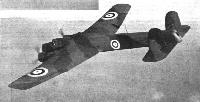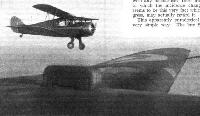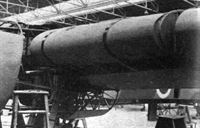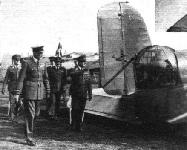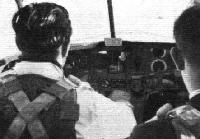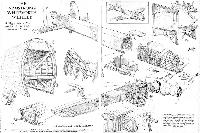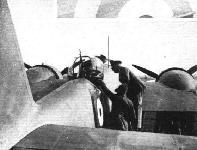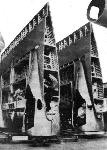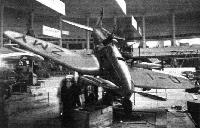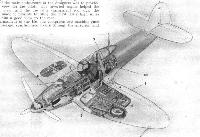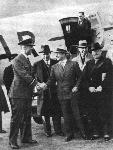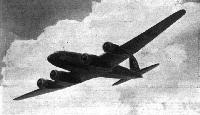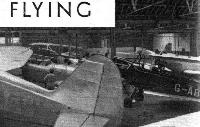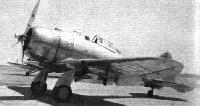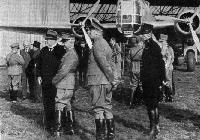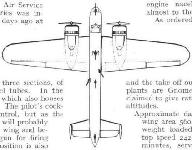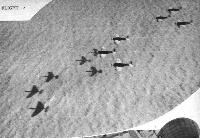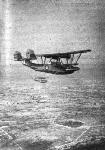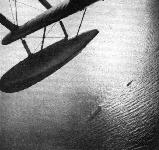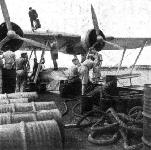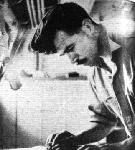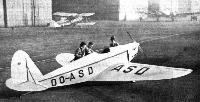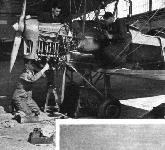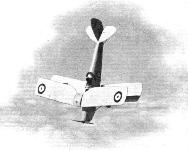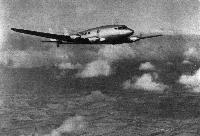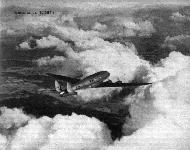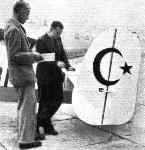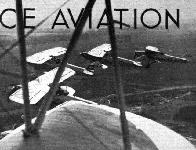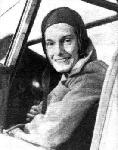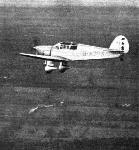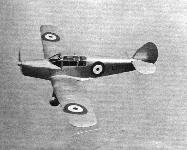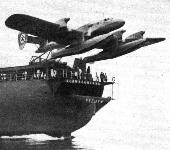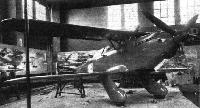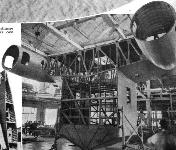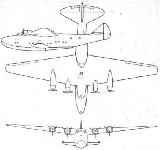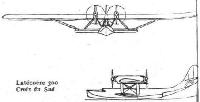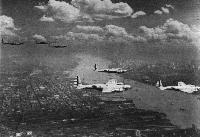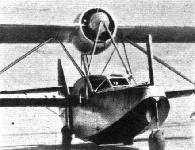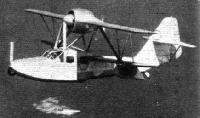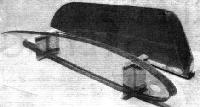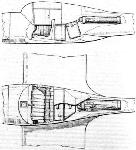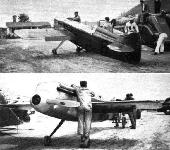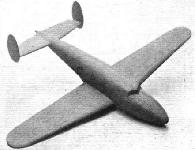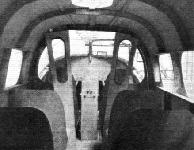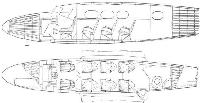Фотографии
-
Регистрационный номер: K7211 [2] Самолёты на фотографии: Armstrong Whitworth Whitley / A.W.38 - Великобритания - 1936
-
Регистрационный номер: K7211 [2] Самолёты на фотографии: Armstrong Whitworth Whitley / A.W.38 - Великобритания - 1936
-
TAKER - AND TAKEN: This snapshot was taken from an Armstrong Whitworth Whitley. In the Avro Commodore, flown by Flt. Lt. Reynell, is Flight's chief photographer, and they are just manoeuvring into position to secure the striking close-up picture.
Самолёты на фотографии: Armstrong Whitworth Whitley / A.W.38 - Великобритания - 1936Avro Commodore / Type 641 - Великобритания - 1934
-
Some constructional features of the Whitley. The leading edge next to the engine mounting; it carries the petrol tanks, shaped to fit the curvature.
Самолёты на фотографии: Armstrong Whitworth Whitley / A.W.38 - Великобритания - 1936
-
Production: A corner of the wing shop at Baginton, showing spar boxes being assembled in their jigs.
Самолёты на фотографии: Armstrong Whitworth Whitley / A.W.38 - Великобритания - 1936
-
More armament: General Milch and Air Chief Marshal Sir Edgar Ludlow-Hewitt lead the party past the tail turret of an A. W. Whitley.
Самолёты на фотографии: Armstrong Whitworth Whitley / A.W.38 - Великобритания - 1936
-
In the cockpit of the Whitley. There is ample room for the two pilots, and the view in all essential directions is unrestricted. At the controls when this picture was taken was F/O. E. S. Greenwood.
Самолёты на фотографии: Armstrong Whitworth Whitley / A.W.38 - Великобритания - 1936
-
THE ARMSTRONG WHITWORTH WHITLEY. A Flight Artist's Exposition of the Main Structural Details
Самолёты на фотографии: Armstrong Whitworth Whitley / A.W.38 - Великобритания - 1936
-
THE ARMSTRONG WHITWORTH WHITLEY. Two Siddeley Tiger IXs - 805 (max.) h.p. each at 7,200 ft.
Самолёты на фотографии: Armstrong Whitworth Whitley / A.W.38 - Великобритания - 1936
-
General Milch, at Mildenhall, watches a demonstration by a gunner in the rear cockpit of a Bristol Blenheim.
Самолёты на фотографии: Bristol Blenheim - Великобритания - 1936
-
Регистрационный номер: HB-IRA SOMETHING DIFFERENT: Last Sunday a Swissair Douglas D.C.3 put into Hatfield for a few minutes. The crew had not come to inspect fhe Albatross but merely to look at Hatfield as a possible reserve when Croydon is impossible.
Самолёты на фотографии: Douglas DC-3 / C-47 Skytrain/С-53 Skytrooper / Dakota - США - 1935
-
Workers in the Douglas factory at Santa Monica well into their job on a D.C.3.
Самолёты на фотографии: Douglas DC-3 / C-47 Skytrain/С-53 Skytrooper / Dakota - США - 1935
-
Interesting new military type flown by its makers' test pilots at the meeting. The Curtiss Y1P-36 (Twin-wasp)
Самолёты на фотографии: Curtiss Hawk 75 / P-36 / Mohawk - США - 1935
-
Регистрационный номер: D-IZMY A particularly welcome exhibit is the Heinkel He. 112 fighter, a diminutive projectile which does about 300 m.p.h. carrying two Oerlikon "cannons" and a pair of machine guns. The engine is an inverted-vee Junkers Jumo 210Ea of 685 (max.) h.p.
Самолёты на фотографии: Heinkel He-112 - Германия - 1935
-
A part-sectional view, by a German artist, of the Heinkel He. 112. Some outstanding features include: (1) Air intake; (2) port machine gun; (3) fuel tank; (4) Oerlikon "cannon"; (5) 10 kg. fragmentation bombs; (6) flap; (7) fuel tank; (8) oil tank; (9) radio; (10) pneumatic gun-operating gear.
Самолёты на фотографии: Heinkel He-112 - Германия - 1935
-
Регистрационный номер: I-LUCE, I-ESTE, I-ESTO The Savoia Marchetti S.79 (three Alfa-built Pegasus) on the right is "I-11," the winner of the Damascus race. It is one of the most arresting machines on show, in its red and green paint. In the background is the new Savoia S.83 transport developed from the S.79 design. This is said to be good for nearly 270 m.p.h.
Самолёты на фотографии: Savoia-Marchetti / SIAI SM.79 Sparviero - Италия - 1934Savoia-Marchetti / SIAI SM.83 - Италия - 1937
-
Регистрационный номер: G-ADHJ Mercury, the upper component of the Short-Mayo effort, during trials on the Medway. This is a comparatively small machine of less than 1,200 h.p.
Самолёты на фотографии: Short Mayo Composite (S.20 Mercury and S.21 Maia) - Великобритания - 1938
-
Регистрационный номер: D-ASAR In civilian dress: The arrival of our German guests at Croydon at the beginning of the week. General Milch is being welcomed by A.V.-M.R.E.C. Peirse. General Wenninger, German air attache, is in front of the cabin door of the Heinkel He.111.
Самолёты на фотографии: Heinkel He-111 - Германия - 1935
-
FEIGNED FLIGHT: With four of the new 830 h.p. Bramo 323 J. Fafnir engines. Lufthansa's new 26-seater Focke-Wulf 200 (Condor), will have a speed of 230 m.p.h. This cleverly faked picture of a model shows the Condor's businesslike appearance.
Самолёты на фотографии: Focke-Wulf FW.200 Condor - Германия - 1937
-
Регистрационный номер: L5945, L5946, L5947, L5948, L5949 A batch of Miles Magisters (Gipsy Major) just emerged from their makers' works at Woodley, Reading. These machines are now in steady production for Service ab initio and blind-flying training.
Самолёты на фотографии: Miles Magister / M.14 - Великобритания - 1937
-
Art Goebie's Boeing 100 sky-writer.
Самолёты на фотографии: Boeing F4B / P-12 - США - 1928
-
Not-so-new equipment: the visitors pass between the ranks of trusty Heyfords, each machine with its crew, in full flying kit, standing to attention.
Самолёты на фотографии: Handley Page Heyford / H.P.38 / H.P.50 - Великобритания - 1930
-
Регистрационный номер: G-AEZE FREIGHT ONLY: One of International Air Freight's Curtiss Condors on the tarmac at Croydon. These machines have been specially modified to take really large pieces of freight and to simplify the loading process.
Самолёты на фотографии: Curtiss Condor 18 - США - 1929
-
THE ILL WIND: A corner of Rollason's hangar at Croydon. In the foreground is a Stinson Reliant, with the little Latvian V.E.F. J.12 behind it and the South African Junkers Junior on the right. One of I.A.F.'s Curtiss Condor freighters can be seen in the far distance.
Самолёты на фотографии: Curtiss Condor 18 - США - 1929Irbitis, VEF I-11 / I-12 / I-17 - Латвия - 1936Junkers A 50 Junior - Германия - 1929Stinson Reliant - США - 1933
-
The somewhat nebulous military Cant triple-engined floatplane. Armament stowage is quite arbitrary at the moment, but the machine will certainly have a good performance. Beyond it is the incredible SS3, concocted at Guidonia.
Самолёты на фотографии: Ambrosini SS.3 / SS.4 - Италия - 1938CANT Z.506B/S Airone - Италия - 1937
-
Регистрационный номер: R70Y Interesting new military type flown by its makers' test pilots at the meeting. The Seversky P.35 (modified Twin Wasp), in racing trim.
Самолёты на фотографии: Seversky P-35 - США - 1936
-
A fly-past at Mildenhall, for the benefit of the guests, by a squadron of Vickers Wellesleys with their external "egg-boxes."
Самолёты на фотографии: Vickers Wellesley - Великобритания - 1935
-
Регистрационный номер: K7733 ASPECT RATIO: Vickers Wellesleys of a unit which demonstrated before our German guests at Mildenhall.
Самолёты на фотографии: Vickers Wellesley - Великобритания - 1935
-
General Milch, at Mildenhall, watches a demonstration by a gunner in the rear cockpit of a Wellesley.
Самолёты на фотографии: Vickers Wellesley - Великобритания - 1935
-
Регистрационный номер: D-ADAA The projection of so much rear armament on the Junkers Ju. 86K bomber is deplorable aesthetically and aerodynamically. The "dustbin" would be more at home in a museum than on such a fine bombing machine.
Самолёты на фотографии: Junkers Ju.86 - Германия - 1934
-
The unfriendly looking aeroplane is the Caproni Ca.135 bomber. The camouflage scheme is a multi-coloured one consisting mainly of red, grey, yellow and green.
Самолёты на фотографии: Caproni Ca.135 - Италия - 1935
-
Officials of the Dutch Army Air Service at Schipol during preliminary trials of the first Pegasus-engined T.5 bomber. The engines, it will be seen, have gilled cowlings.
Самолёты на фотографии: Fokker T.V - Нидерланды - 1937
-
Самолёты на фотографии: Fokker T.V - Нидерланды - 1937
-
Самолёты на фотографии: Fokker T.V - Нидерланды - 1937
-
Регистрационный номер: F-ANLG Farman is developing some high-performance landplanes from the Centaure type which is being used on the South American service.
Самолёты на фотографии: Farman F.220 / F.221 / F.222 - Франция - 1932
-
The Piaggio P.32 bomber (left) has a peculiar high-lift device permitting a strikingly short span. On the right the golden Breda 65 fighter-attack machine is caught taking off at a very tail-up attitude.
Самолёты на фотографии: Breda Ba.65 - Италия - 1935Piaggio P.32 - Италия - 1936
-
Flight of fancy - strange duck-like shadows cast by a formation of U.S. Army Northrops
Самолёты на фотографии: Northrop A-17 / 8A Nomad - США - 1934
-
Lethal Trails: Northrop A.17 attack machines demonstrate gas dispensation
Самолёты на фотографии: Northrop A-17 / 8A Nomad - США - 1934
-
TRAINING CRUISE: Camera impression by one who took part in the recent training cruise of No. 204 (G.R.) Squadron to Malta. Two of the boats, returning to England;
Самолёты на фотографии: Saunders-Roe London / A.27 - Великобритания - 1934
-
TRAINING CRUISE: Camera impression by one who took part in the recent training cruise of No. 204 (G.R.) Squadron to Malta. H.M.S. Glorious with attendant destroyer from 3,000 ft;
Самолёты на фотографии: Saunders-Roe London / A.27 - Великобритания - 1934
-
TRAINING CRUISE: Camera impression by one who took part in the recent training cruise of No. 204 (G.R.) Squadron to Malta. Refuelling at Gibraltar from 50 gall, drums by means of the boat's auxiliary engine. Note the extra long-range tank.
Самолёты на фотографии: Saunders-Roe London / A.27 - Великобритания - 1934
-
TRAINING CRUISE: Camera impression by one who took part in the recent training cruise of No. 204 (G.R.) Squadron to Malta. The navigator of one of the four Londons - P/O. Hyde - at work;
Самолёты на фотографии: Saunders-Roe London / A.27 - Великобритания - 1934
-
PIRATES BEWARE! No. 209 (G.R.) Squadron arriving at Malta from Felixstowe on September 19. The Squadron has been taking part in anti-piracy patrols
Самолёты на фотографии: Short Singapore III / S.19 - Великобритания - 1934
-
HONOLULU BOUND: Such a prosaic excrescence as the wing-tip float of a Sikorsky S.43, used on the Hawaiian inter-island service, assumes a dramatic aspect against this Pacific background.
Самолёты на фотографии: Sikorsky S-43 Baby Clipper/JRS/Y1OA-8 - США - 1936
-
Самолёты на фотографии: De Havilland Dragon Rapide / Dominie / D.H.89 - Великобритания - 1934
-
Going on parade: A Flight photograph taken from one of the units of a Squadron of Harrows on the way to Mildenhall.
Самолёты на фотографии: Handley Page Harrow / H.P.54 - Великобритания - 1936
-
Регистрационный номер: OO-ASD MORE POWER FOR THE TIPSY: A single-seater Tipsy monoplane has now been fitted with a 40 h.p. four-in-line inverted Train engine, giving the machine a cruising speed of 110 m.p.h. This special Tipsy is sold over here by Brian Allen Aviation, of Croydon, at ?395.
Самолёты на фотографии: Tipsy S - Бельгия - 1935
-
Регистрационный номер: L6923 [3] Самолёты на фотографии: De Havilland Tiger Moth / D.H.82 - Великобритания - 1931
-
"Twenty-Five-Hour": At work on one of the Club Tigers - now the standard training type at Brooklands.
Самолёты на фотографии: De Havilland Tiger Moth / D.H.82 - Великобритания - 1931
-
Регистрационный номер: L6923 [3] The photograph of the Tiger Moth, which looks rather upset in the hands of Test-Pilot Buckingham, was obtained on quite a different occasion. Below the clouds it was just an ordinary grey overcast autumn day, yet here again are blue sky and sunshine unlimited.
Самолёты на фотографии: De Havilland Tiger Moth / D.H.82 - Великобритания - 1931
-
Регистрационный номер: L6923 [3] Самолёты на фотографии: De Havilland Tiger Moth / D.H.82 - Великобритания - 1931
-
Самолёты на фотографии: De Havilland Tiger Moth / D.H.82 - Великобритания - 1931
-
Panorama: The new building can be seen behind the Club fleet, which is lined up on the tarmac in the centre picture.
Самолёты на фотографии: De Havilland Tiger Moth / D.H.82 - Великобритания - 1931
-
Регистрационный номер: G-ADJB, G-ADJH Самолёты на фотографии: De Havilland Tiger Moth / D.H.82 - Великобритания - 1931
-
IN SERVICE DRESS: To replace the D.H.89 which members of the Air Council have used for their official journeys since 1935, the De Havilland Company last week delivered this D.H.86B. This well-known commercial type, with its four 200 h.p. Gipsy Six I engines, cruises at 140 m.p.h.
Самолёты на фотографии: De Havilland Express Air Liner / D.H.86 - Великобритания - 1934
-
Mr. Douglas Fawcett with his Hornet Moth. An experienced mountaineer, he spends much of his time in Switzerland, flying blissfully in all sorts of weather, over, around and among the peaks which he knows so well. He is the brother of Colonel Fawcett, who disappeared while exploring the Amazon.
Самолёты на фотографии: De Havilland Hornet Moth / D.H.87 - Великобритания - 1934
-
Регистрационный номер: G-AEVV [2] ON HER WAY: Trials of the De Havilland Albatross high-speed, long-range transport are still proceeding at Hatfield and this most beautiful of all large aeroplanes is frequently seen over Hertfordshire slipping along comfortably at her 210 m.p.h. cruising speed. This, her latest picture, was obtained during trials by Major Hereward de Havilland.
Самолёты на фотографии: De Havilland Albatross / D.H.91 - Великобритания - 1937
-
Регистрационный номер: G-AEVV [2] The picture shown here of the De Havilland Albatross, undergoing routine tests for the Air Ministry, was taken on an exceptionally beautiful day for October, and to fly alongside this piece of silver loveliness against an ever-changing background of sunlight and shadow was sheer delight.
Самолёты на фотографии: De Havilland Albatross / D.H.91 - Великобритания - 1937
-
STAR AND CRESCENT: Messrs. R. H. Somerset and L. Castlemaine, the General Aircraft pilots who left Hanworth on Sunday with two Monospars for delivery to the Turkish Air League, which will use them for instruction in parachute jumping. The doors of the machines have been slightly modified for the purpose.
Самолёты на фотографии: General Aircraft Monospar ST-25 Universal - Великобритания - 1935
-
Регистрационный номер: G-ADMV The Hafner Gyroplane in this photograph has taken off from a standstill on the compass base seen a few yards to the rear.
Самолёты на фотографии: Hafner AR.III Gyroplane - Великобритания - 1935
-
CLOSE COMPANY: Hawker Demon two-seater fighters (derated Kestrel V) of No. 64 (F) Squadron caught by the Flight camera immediately after a formation take-off at Martlesham Heath.
Самолёты на фотографии: Hawker Demon - Великобритания - 1932
-
A happy photograph of Miss Batten framed in the cockpit of her Gull. Behind her can be seen the petrol tank which in the tropics became too hot to touch.
Самолёты на фотографии: Percival Gull - Великобритания - 1932
-
Регистрационный номер: G-ADPR, AX866 A dull afternoon greeted Miss Batten on arrival at Lympne. Her Gull is here seen over Kent en route for Croydon.
Самолёты на фотографии: Percival Gull - Великобритания - 1932
-
Регистрационный номер: L7272, G-AFWG A Percival Vega Gull (Series I Gipsy Six) which is at present being shipped out to Buenos Aires for the use of the British Air Attache there, Group Capt. A. J. Miley, and his assistant, Sqn. Ldr. P. C. Wood. A Vega Gull is already in use by the Attache in Berlin, Group Capt. F. P. Don.
Самолёты на фотографии: Percival Vega Gull / K.1 - Великобритания - 1935
-
Регистрационный номер: G-ADHM ATLANTIC SURVEY: Caledonia taxies to her moorings at Horta, Azores, after her recent survey trip in command of Captain Powell.
Самолёты на фотографии: Short Empire / S.23 - Великобритания - 1936
-
Регистрационный номер: F-AOVV Bretagne, the French Loire 102, is claimed to have a top speed of 192 m.p.h. with four 720 h.p. Hispano-Suiza Series X engines. The appearance of the machine would suggest something considerably lower.
Самолёты на фотографии: Loire Loire 102 Bretagne - Франция - 1936
-
Loire 102.
Самолёты на фотографии: Loire Loire 102 Bretagne - Франция - 1936
-
The Liore et Olivier H.47 flying boat which, had it not crashed during trials, would have been used by Air France Transatlantique for experimental crossings. With four 860 h.p. Hispano-Suiza Series Y engines, this machine was said to be very fast indeed.
Самолёты на фотографии: Liore et Olivier LeO H.47 - Франция - 1936
-
Liore et Olivier H.47.
Самолёты на фотографии: Liore et Olivier LeO H.47 - Франция - 1936
-
Регистрационный номер: D-AMIE Nordmeer, one of the two Blohm and Voss Hamburger floatplanes with four Junkers Jumo diesel engines, built specially for transatlantic work. The machine is seen leaving the Heinkel catapult of one of Lufthansa's "floating bases."
Самолёты на фотографии: Blohm und Voss Ha.139 - Германия - 1936
-
The Romeo Ro. 51 fighter on the left is one of the few military models with a fixed undercarriage. Beyond is the Breda 82 bomber, which, the makers say, is as fast as a Blenheim.
Самолёты на фотографии: Breda Ba.82 - Италия - 1937IMAM(Meridionali) Ro.51 - Италия - 1937
-
The Caproni Ca.134 is the latest word in Italian military biplanes. Intended for army co-operation, it has twin rudders, an outlandish undercarriage and a 900 h.p. Isotta.
Самолёты на фотографии: Caproni Ca.134 - Италия - 1937
-
In the foreground is the little S.A.I.3 two-seater with the S.A.I.2 cabin machine beyond. The flying boat is the new Macchi MC 99 bomber-reconnaissance machine with a pair of Isotta Assos of 750 h.p. each.
Самолёты на фотографии: Macchi MC.99 - Италия - 1937SAI Ambrosini SAI.2 - Италия - 1935SAI Ambrosini SAI.3 - Италия - 1937
-
THE WORLD'S LARGEST LANDPLANE: The Boeing XB-15, which is much bigger even than the YB-17s and which is probably the largest landplane now flying, spurns back the soil on an early test take-off. Designed in the first instance for engines of 1,500 - 2,000 h.p., she is fitted at the moment with four 1,000 h.p. Twin Wasps.
Самолёты на фотографии: Boeing B-15 - США - 1937
-
An impression of the Boeing 307 "Stratoliner" landplane. At least one of these machines, now being built at Seattle, is likely to be used by P.A.A. for transatlantic work. It will have a pressure cabin for sub-stratosphere flying.
Самолёты на фотографии: Boeing Boeing 307 Stratoliner - США - 1938
-
Centre section of one of the new Atlantic Boeing boats for P.A.A.
Самолёты на фотографии: Boeing Boeing 314 Clipper - США - 1938
-
Регистрационный номер: NC18601 A sectioned view of the Boeing 314 Super Clipper of the type which, with auxiliary tankage, is likely to be used some time next year for transatlantic experiments. The engines are four Wright two-row Cyclones of about 1,500 h.p. each.
Самолёты на фотографии: Boeing Boeing 314 Clipper - США - 1938
-
General arrangement of the Boeing 314 flying boat.
Самолёты на фотографии: Boeing Boeing 314 Clipper - США - 1938
-
Road-clearers - Lockheed Electras on their way from the docks to Essendon Aerodrome, Melbourne.
Самолёты на фотографии: Lockheed Electra 10 - США - 1934
-
TEST FLIGHT: The first of the new Lockheed "14s" photographed on its first flight. Apparently the machine has come up to, or even exceeded, its estimated performance figures, though it is rumoured that the Fowler flap gear demands a new approach technique. K.L.M. are the first European transport firm to place orders for this type which has an estimated cruising speed of about 240 m.p.h. depending on the particular engines installed - whether Cyclones or Hornets.
Самолёты на фотографии: Lockheed Super Electra 14 - США - 1937
-
YET ANOTHER U.S. DESIGNATION: Major Alexander de Seversky takes off in the so-called "Convoy Fighter" (Wright Cyclone).
Самолёты на фотографии: Seversky SEV-2PA / AT-12 - США - 1937
-
The Sikorsky S.42. A slightly modified version has been used for transatlantic experiments.
Самолёты на фотографии: Sikorsky S-42 Clipper - США - 1934
-
THE NEW EAGLE: During the past few months British Aircraft have been trying out a new version of the well-known Eagle. This has a fixed undercarriage, and, for those who prefer to be relieved of retractable responsibility, the machine has certain definite advantages. The greater virtual wing-area and the decreased drag have resulted in a considerably improved take-off and a slower landing, while the causing speed (at 2,000 r.p.m.) is still rather better than 120 m.p.h.
Самолёты на фотографии: British Klemm BK-1 Eagle - Великобритания - 1934
-
Latecoere 300 Croix du Sud.
Самолёты на фотографии: Latecoere Late 300 / 301 - Франция - 1931
-
Регистрационный номер: G-ABGS Maintenance: A few of the machines which are now going through their C. of A.s, or being otherwise attended to, can be seen in the picture of the maintenance department. On the left of the shop, and outside the picture, are the dope and fabric shops, the bonded stores and various administrative offices.
Самолёты на фотографии: De Havilland Puss Moth / D.H.80 - Великобритания - 1929
-
Регистрационный номер: G-AFBT The flying test-bed for the Bristol Hercules engine is a Northrop monoplane. Note the long-chord cowling with controllable cooling gills. The position of the air intake above the cowling is interesting.
Самолёты на фотографии: Northrop Gamma / A-13 / A-16 - США - 1932
-
Регистрационный номер: G-ACSU Filling up: The refuelling and "re-oiling" pumps are all conveniently concentrated at the tarmac end of the new building. The oil, incidentally, is supplied under pressure through a number of filters.
Самолёты на фотографии: De Havilland Leopard Moth / D.H.85 - Великобритания - 1933
-
Регистрационный номер: NR15320, X15320 THE BURNELLI IN ENGLAND: On Monday of this week the American version of the Burnelli was flown over to Croydon from Rotterdam by Mr. S. V. Morton. The owner is Sir Cuncliffe Owen, who originally entered this or a similar machine in the abandoned Atlantic race.
Самолёты на фотографии: Burnelli UB-14 - США - 1934
-
BIGGER STILL: Boeing YB-17 long-range heavy bombers of the U.S. Army Air Corps over New York City. Eventually about forty of these Cyclone-powered giants will be in service. Apart from providing useful practical data they have enabled the Boeing concern to solve problems in the construction of four-engined transports and flying boats.
Самолёты на фотографии: Boeing B-17 Flying Fortress - США - 1935
-
One of the 'blister' turrets of the Boeing YB-17 bomber.
Самолёты на фотографии: Boeing B-17 Flying Fortress - США - 1935
-
Регистрационный номер: X18136 An experimental, private-owner type, the PJC-1, which has recently carried out its test flights quite successfully on the comparatively small power of a Warner Super-Scarab.
Самолёты на фотографии: Harlow PJC-1 / PJC-2 - США - 1937
-
Latecoere 521 Lieutenant de Vaisseau Paris
Самолёты на фотографии: Latecoere Late 521 / 522 / 523 - Франция - 1935
-
Bleriot 5190 Santos Dumont.
Самолёты на фотографии: Bleriot Bleriot 5190 Santos Dumont - Франция - 1933
-
Designed in 1933: The Curtiss-Courtney amphibian had a retractable nose wheel as well as retractable main wheels. In addition to being almost buried while in flight, the nose wheel of the amphibian formed a useful fender when coming up to moorings.
Самолёты на фотографии: Curtiss-Wright CA-1 Commuter / Courtney Amphibian - США - 1934
-
Самолёты на фотографии: Curtiss-Wright CA-1 Commuter / Courtney Amphibian - США - 1934
-
DUAL PURPOSE: The much-talked-of Pitcairn "Roadable" Autogiro in its latest form. The Pobjoy Niagara which powers the machine is installed "on its side" in the fuselage and is cooled by special air-ducts. Curiously enough, the machine does not appear to be quite as fast as it was when the engine was mounted conventionally in the nose. Probably the air-duct system introduces new air-flow problems.
Самолёты на фотографии: Pitcairn PA-22 - США - 1932
-
C. H. Gotch's Keith-Rider Special, which have small Menasco in-line engine.
Самолёты на фотографии: Rider R-1 / R-2 / R-4 / R-5 / R-6 - США - 1931
-
Регистрационный номер: G-AEMA A rib and elevator in Noral, which material is being extensively employed in the production Cygnets.
Самолёты на фотографии: C.W. Aircraft Cygnet - Великобритания - 1937
-
The Cygnet accommodates pilot and passenger and has liberal stowage for luggage and sports gear. It will be seen that the seat now extends across the cabin.
Самолёты на фотографии: C.W. Aircraft Cygnet - Великобритания - 1937
-
Регистрационный номер: R68Y The Delgado, which have small Menasco in-line engine, built by students, is comparable with our T.K.4.
Самолёты на фотографии: Delgado Flash - США - 1937
-
Two views of the Wittman-Curtiss racer, the only water-cooled machine at the races; in one event it averaged 276 m.p.h. for two laps round four pylons.
Самолёты на фотографии: Wittman D-12 Bonzo - США - 1936
-
Earl Ortman's Keith Rider (Twin Wasp Junior), originally built for the MacRobertson race, and twice rebuilt since. It has tankage for 3,000 miles.
Самолёты на фотографии: Rider R-3 - США - 1934
-
Регистрационный номер: FW-005 Something novel in the French "prototype tour" - the Claude "Canard Aquilon". It is said to cruise at 90 m.p.h. on 40 h.p.
Самолёты на фотографии: Nicolas-Claude NC-2 Aquilon - Франция - 1937
-
Mr. R. S. Dickson, C.W.'s chief draughtsman on the Swan, surveys the mock-up of his very efficient-looking design. The nacelles, it will be noticed, are for Gipsy Sixes, although the prototype may have Wasp Juniors.
Самолёты на фотографии: C.W. Aircraft Swan - Великобритания - 1937
-
The wind-tunnel model of the Swan less nacelles. Note the extraordinarily neat tail
Самолёты на фотографии: C.W. Aircraft Swan - Великобритания - 1937
-
The amply wide cabin gangway and the central control bank in the cockpit are features revealed in this view taken in the mock-up
Самолёты на фотографии: C.W. Aircraft Swan - Великобритания - 1937
-
The drawing shows that commodious baggage compartments and, considering the performance, a roomy cabin, characterise the machine
Самолёты на фотографии: C.W. Aircraft Swan - Великобритания - 1937
-
The C.W. Swan (Choice of in-line or radial engines)
Самолёты на фотографии: C.W. Aircraft Swan - Великобритания - 1937
-
Another experimental type of unorthodox layout, the Sundorph A-1, powered with a Jacobs L-5. This, like the PJC-1, is a stressed-skin job and is in the same class as the Beechcraft and Stinson. The Sundorph flew in the Bendix Trophy race, but apparently developed wing flutter and retired.
Самолёты на фотографии: Sundorph A-1 Special - США - 1937
Статьи
- Flight
- Flight Advertisements

